Maintaining Iron
Antiques
by Bob Brooke
Wood and iron were the
two most common materials used to make everyday objects in the 18th and
19th centuries. Blacksmiths turned wrought iron—grainier than cast iron
and usually marked by the forge—into tools, weather-vanes, fireplace
accessories, trivets, and keys. Ironmakers produced cast iron—harder and
more brittle but with a smoother surface—as early as the 14th century,
but it wasn't until the mid 19th century that it became the virtually
universal replacement for wrought iron. Cast iron, too, was made into
the full gamut of objects from furniture to cooking pots to toothpick
holders.
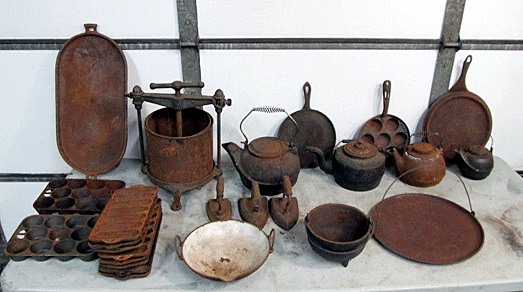
In order to make sure antique iron objects stand the test of time, it’s
necessary to clean and protect them.
How to Clean Rusted Iron
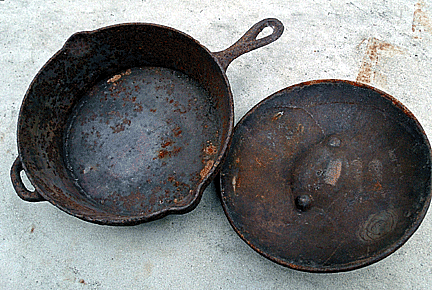 Rust
is the major enemy of iron and, and though slow, it’s extremely sure.
Unchecked, rust will eat away until the entire object disintegrates. Low
humidity will usually stabilize the rust so that corrosion isn't active
and no further destruction takes place. So you have a choice. If you
think polishing will only emphasize an eroded surface, you can leave the
rust and treat the object to prevent further damage, or you can clean it
back to a proximity of its original state. The decision is up to you. Rust
is the major enemy of iron and, and though slow, it’s extremely sure.
Unchecked, rust will eat away until the entire object disintegrates. Low
humidity will usually stabilize the rust so that corrosion isn't active
and no further destruction takes place. So you have a choice. If you
think polishing will only emphasize an eroded surface, you can leave the
rust and treat the object to prevent further damage, or you can clean it
back to a proximity of its original state. The decision is up to you.
Here are the usual steps to clean iron or steel:
1.Wash with warm
water and a little mild detergent.
2.Scrub with kerosene or turpentine to remove any oils or grease.
3.Polish with steel wool or aluminum oxide paper (Tri-M-ite), using
grits of 600 or 400. If you want to remove rust, you can combine a
commercial rust-removing liquid with this step (be sure to wear
rubber gloves or your hands will be a mess).
4. Rinse thoroughly, dry with a cloth, then let sit in your oven at
lowest heat (not more than 200 F.) for an hour or so to dry out
completely.
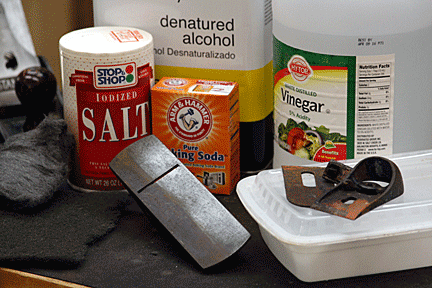
Other Rust Removers
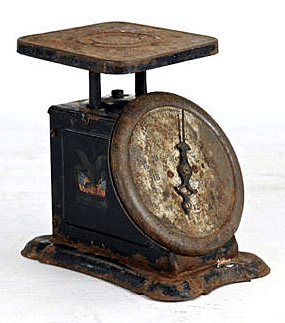 Baking
soda, vinegar, citric acid, lemon, and salt are good cleaners for a
variety of rusted conditions. Baking
soda, vinegar, citric acid, lemon, and salt are good cleaners for a
variety of rusted conditions.
Baking soda works best on severe rust. When using it, rinse the object
and shake it dry. Dust it with baking soda, which will adhere to the
damp areas. Make sure you cover all rusty areas. Leave the item for an
hour or so, then scour it with steel wool or a metal brush, removing the
rust down to the metal. Rinse, and towel dry. Be aware that it can take
up to an hour before you can really start to work away the rust. Be
prepared to use some elbow grease.
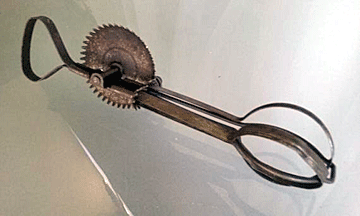 Vinegar
works best on significant rust found on tools and on objects that can be
submerged without compromising the integrity of other surfaces. Submerge
your object in white vinegar and let it sit overnight. Remove it from
the vinegar and scrape it with a metal brush or steel wool. If your item
can’t be submerged, soak rags in white vinegar and wrap the rusted area. Vinegar
works best on significant rust found on tools and on objects that can be
submerged without compromising the integrity of other surfaces. Submerge
your object in white vinegar and let it sit overnight. Remove it from
the vinegar and scrape it with a metal brush or steel wool. If your item
can’t be submerged, soak rags in white vinegar and wrap the rusted area.
This “let sit and forget” method is easy and takes hardly any elbow
grease to work away the rust once you remove item from the vinegar.
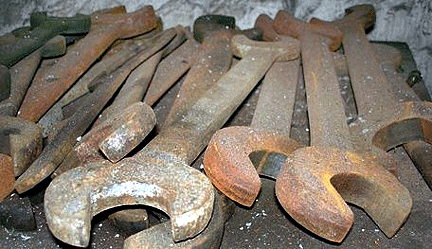
 Citric
acid works similar to vinegar. While you may not have this lying around
the house, you can easily find it at most health food stores. Add a few
inches of hot water to a bowl and sprinkle in two to three tablespoons
of the citric acid. Submerge your object and let it sit overnight. In
the morning, remove it and scrub off lingering rust flecks with a brush,
rinse, and pat dry. This is an alternative “let sit and forget” method. Citric
acid works similar to vinegar. While you may not have this lying around
the house, you can easily find it at most health food stores. Add a few
inches of hot water to a bowl and sprinkle in two to three tablespoons
of the citric acid. Submerge your object and let it sit overnight. In
the morning, remove it and scrub off lingering rust flecks with a brush,
rinse, and pat dry. This is an alternative “let sit and forget” method.
For less stubborn rust stains, or on objects such as kitchen utensils
that may have a little rust here and there, salt and lemon work well.
Generously coat the rusted area in a layer of salt, cut a lemon in half
and squeeze the juice over the salt. Let the mixture sit, then scrub
away the rust with the rind. If rust remains, repeat the procedure and
let the salt and juice sit for another hour or two, until rust
disappears completely. Rinse, then pat dry.
Protecting Cleaned Iron Objects
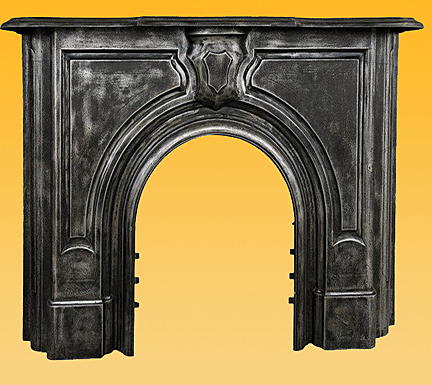 Never
use linseed oil on iron, because it polymerizes and creates a hard
surface that’s virtually impossible to remove. The best protective agent
is hard paste wax or shoe polish. Some polishes contain water and tannic
acid, so check the label to avoid these. Use a clear shoe polish or a
car wax, let dry for a few minutes before polishing, wipe thoroughly and
apply two or three times to build up a good, hard coat. Once you
complete this treatment, you’ll need to do little more than dust.
Unfortunately, this will protect your piece but eventually soften. It's
just like a shoe shine good for a day unless you walk through water. Never
use linseed oil on iron, because it polymerizes and creates a hard
surface that’s virtually impossible to remove. The best protective agent
is hard paste wax or shoe polish. Some polishes contain water and tannic
acid, so check the label to avoid these. Use a clear shoe polish or a
car wax, let dry for a few minutes before polishing, wipe thoroughly and
apply two or three times to build up a good, hard coat. Once you
complete this treatment, you’ll need to do little more than dust.
Unfortunately, this will protect your piece but eventually soften. It's
just like a shoe shine good for a day unless you walk through water.
To keep your iron objects from rusting again, you’ll need to keep them
in a low humidity environment. Summer is often damp in many places due
to rains, so it’s important to be particularly vigilant then.
Any of the old-fashioned stove polishes, consisting of black graphite
with petroleum oil, will add color and a pleasant sheen. If you use
black shoe polish or wax, the effect will initially be the same, but the
surface may soon take on an undesirable look of having been painted.
If you live in a humid climate, an air conditioner or a dehumidifier is
a worthwhile investment to help keep iron from corroding. White cotton
gloves will also help you to protect polished iron from your moist
fingerprints.
<
Back to Caring for Your Collections
Archives
Next
Article >
|
